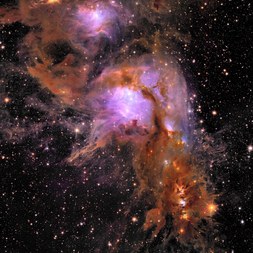First exclusive results and images from the Euclid Space Telescope

Euclid’s new image of star-forming region Messier 78 Credit: ESA/Euclid/Euclid Consortium/NASA, image processing by J.-C. Cuillandre (CEA Paris-Saclay), G. Anselmi; CC BY-SA 3.0 IGO or ESA Standard Licence.
(23-05-2024) Ghent University researchers collaborated in international team to provide the most precise map of our Universe over time.
Today, the Euclid Consortium releases early scientific papers based on observations made by the Euclid telescope. The Euclid telescope was launched on July 1st, 2023, and began its cosmological survey on February 14th, 2024.
A number of scientifically exciting targets have been observed and analyzed by scientists of the Euclid Collaboration during an Early Release Observations (ERO) phase, giving a glimpse of the unprecedented power of this telescope meant to provide the most precise map of our Universe over time.
New planet candidates, new galaxies, and more
An Early Release Observations program was conducted during Euclid’s first months in space as a first look at the depth and diversity of science Euclid will provide. The Euclid Collaboration has now concluded some of the early scientific analyses that were carried out with these ERO data, and publicly releases the associated papers and data today.
Some of the science includes: new-born free-floating planet candidates, newly identified extragalactic star clusters, new low-mass dwarf galaxies in a nearby cluster of galaxies, and the discovery of very distant bright galaxies (seen during the first billion years of the Universe).
These science outputs demonstrate Euclid’s excellent performance and ability to deliver the expected precision for various targets, as well as the smooth and effective analysis of the data within the Euclid Collaboration, auguring well for the mission's future.
Papers & images
- The Overview paper provides a summary of the Euclid mission, covering its scientific goals, spacecraft details, survey planning, data products, planned analysis, and more. It will remain, during the whole mission, a reference for the broader scientific community interested in Euclid data and scientific results.
- The VIS, NISP and NISP Calibration papers describe Euclid’s instruments’ specifications, design, development, and roles within the mission. The VIS (for Visible) instrument, a 609 Megapixel optical-band imager ; and the NISP (for Near Infrared Spectrometer and Photometer) instrument, a multiband photometer also capable of slitless spectroscopy, are Euclid’s key features. They provide exquisite data to map the large-scale structure of our Universe over time to constrain the nature of dark energy and the validity of general relativity on cosmological scales. Performance verification tests indicate that both instruments are operating at fully in line with expectations.
- Finally, the SIM paper introduces the Euclid Flagship simulation, a simulated catalog of billions of galaxies based on the largest cosmological simulation ever conducted, designed to prepare the scientific exploitation for the Euclid mission. Developed to train and validate the ground segment algorithms before the launch, simulations are now used to measure, calibrate and correct systematic biases.
- All papers are available at Euclid Consortium Publications
- Euclid's first images: the dazzling edge of darkness
Ghent University researchers in the Euclid Consortium
The Euclid Consortium comprises more than 2600 members, including over 1000 researchers from more than 300 laboratories in 15 European countries, plus Canada, Japan and United States, covering various fields in astrophysics, cosmology, theoretical physics, and particle physics. Two Ghent University researchers collaborate in this project:
- Sven De Rijcke is the Belgian representative in the Euclid Consortium Board, and the PI of the PRODEX project BESE (Belgian Euclid Science Exploitation) that employs four postdocs, one of them at Ghent University, to support the Belgian Euclid effort. He is mostly interested in testing different ideas about the physical nature of dark matter using Euclid images of nearby dwarf galaxies.
- Maarten Baes uses Euclid data to constrain the physical properties of the stellar populations of the observed galaxies.
Contact
Sven De Rijcke
Sven.DeRijcke@UGent.be
09 264 47 91